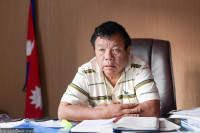Interviews
Nepal is a yam between three boulders
You can’t clearly distinguish between international and domestic factors responsible for the change in ruling coalition.
Thira Lal Bhusal
Earlier this month, Prime Minister Pushpa Kamal Dahal suddenly ditched the Nepali Congress and embraced the CPN-UML to form a new ruling coalition. Though not entirely unexpected, the development still surprised many. The Post’s Thira Lal Bhusal talked to (left-leaning) political analyst Khagendra Prasai, who is also dean of Nepal Open University, about the reasons (for the new alliance) as well as its upshots.
How do you analyse the latest political changes, especially a change in the ruling coalition?
You must consider a few important things. These days, the changes in political equations and the making and breaking of alliances are also influenced by our geopolitics. Earlier, India used to enjoy monopolistic control here. Sometimes, it used to have a decisive role; sometimes, it used pressure. And, Nepali leaders themselves felt obliged to the southern neighbour. Therefore, Nepali politics tilted more towards India. But, over the past decade, the geopolitical scenario changed rapidly. India no longer remains the only international force influencing things here. American involvement has increased mainly with the implementation of the Millennium Challenge Corporation (MCC) Programme. The Chinese, who used to be passive in such activities, are active too. In fact, they are compelled to be active. Increased involvement of these three major powers in Nepal has of late greatly influenced the political equations.
Do you consider foreign influence a primary or secondary factor in Nepal’s political changes?
In a globalised world, you can’t categorically say this one is a primary factor and that one a secondary factor. International influence is important; sometimes it becomes decisive, and sometimes, it is as you put it, a secondary factor.
Was it the major factor in the latest political change?
It might have played a role. You see, the Chinese were not very happy with whatever was going on in Nepal. And they might have expressed that and reacted accordingly. We didn’t see India’s active involvement in the latest political change. Some think there were movements from the US side. Many say the Chinese played a role. It’s not hidden that the Chinese always want left parties to join hands in Nepal, just like India and Western forces try to unify capitalist parties here. This is not something unusual. Therefore, I am saying you can’t clearly distinguish between international and domestic factors and see the development in isolation.
As a country that abides by non-alignment, how can Nepal maintain balance in its foreign policy amid such an active involvement of major forces?
We need to understand non-alignment policy in the new international context as things have changed a lot after the Cold War era. In the past, it was a bipolar competition between capitalism and socialism. They also described it as a democracy versus dictatorship. As we are now in a multipolar world, we can’t see things in that simplistic way. We need to reformulate that concept. The big powers themselves are interdependent. India is emerging as a big power. It is historically close to Russia. But at the same time, the US is trying to cultivate India as the most reliable partner to encircle China.
India and the US have significantly expanded their cooperation in recent years. On the other hand, China and India are major trade partners. China and the US are also major trade partners. This is how the world dynamics are changing. China has moved ahead in recent years. It has come up with its own Global Security Initiative (GSI). So, we have to redefine our policy. While doing so we should stress on peace, national security. And we should be equally sensitive to the security sensitivities of India and China. We should understand that both the neighbours want political forces in Nepal that understand their national security concerns. It is a stated policy of the US to intervene in Tibet affairs. So, Nepal’s location is also important. The Chinese are conscious about this.
Let’s come back to domestic politics. How do you analyse the prime minister’s decision to change coalition partners three times within 15 months?
There are three important factors. First, the current equation in the Parliament calls for a coalition. Either you have to go for midterm elections or form coalitions. Second, our political leaders are ready to make and break partnerships anytime. It is mainly happening because there are no ideological demarcations between them. All parties are pursuing neoliberal capitalist policies. They are not different even on paper. The communist parties say, “At this stage, we can’t pursue socialist policies as we are in a stage of capitalist development”. So, they are implementing capitalism. Congress is openly and always for capitalism. So, any of the parties can join hands with any other.
The third factor is geopolitics. We are no longer a yam between two boulders as King Prithvi Narayan Shah described over 250 years ago. Now, it is in fact a yam between three boulders [India, China and the US], which are quite active. Their influence is sometimes subtle and sometimes open. Our internal politics can’t remain untouched by these dynamics. While analysing the formation and dissolution of coalitions, we can’t give an accurate picture if we see things based only on the personality of Pushpa Kamal Dahal, Sher Bahadur Deuba or KP Sharma Oli. Big structural forces are causing changes here.
Many argue that international forces like India, China and the US are busy handling more complex issues around the world, and don’t have time to engage in internal affairs of Nepal.
That is a naive argument. Those who have studied Indian and American foreign policy documents won’t say so. The US documents say they need the Indo-Pacific Strategy to encircle China and that Nepal can be a dependable partner to implement that. Similarly, a study conducted by a parliamentary committee of India states that India has to increase support to Nepal and Bangladesh citing China’s increased investment in India’s backyard. There are many such official documents. Who says they aren’t interested in Nepal’s domestic affairs? The US documents say they should invest in making countries suitable for American interests. We know what Indians do. Now, even the Chinese don’t take Nepal’s political developments only as our domestic affairs. If a political party is too close with the US while distancing itself from China, it becomes suspicious of that force.
What about the Chinese documents, aren’t they accessible?
If you read the Global Security Initiative (GSI) of China, there is no policy of confronting others. They don’t have such a policy. They don’t describe any country as an enemy while, conversely, the US documents describe four countries—China, Russia, Iran and North Korea—as their enemies and threats to democracy and peace. The argument that they [world powers] don’t have time to engage in micromanagement in a country like Nepal is baseless. The US wants to have one or two dependable forces in Nepal. It’s their stated policy. So, they also want to develop new forces for that. This is a challenge as well as an opportunity for us. Such engagements may turn Nepal into a battleground while it can also increase our bargaining power.
Our electoral system is creating hung parliaments, which is quite favourable for international forces to manoeuvre. Is instability going to perpetuate here?
That risk is there. They have more room to manoeuvre in a political situation like ours.
Then, from this perspective, do we need to review our electoral system?
We need to rethink an electoral system that makes it hard for major political forces to garner a majority in Parliament. We have to consider how we can strike a balance between inclusion and stability. Ironically, even a single-party majority doesn’t guarantee political stability. Girija Prasad Koirala became prime minister after the Nepali Congress won majority seats after the reinstatement of democracy in 1990. Also, the then Nepal Communist Party had an absolute majority in parliament when KP Sharma Oli was prime minister, just a few years ago. Both of them squandered the opportunities. Forming a coalition in itself isn’t bad. In some countries, coalitions have worked well. But they should be based on a certain ideology, principle, policy or purpose.
The UML and Maoist leaders have again come together to run the government. Do you see a possibility of another left unity?
First of all, none of them are left [communist] parties in the true sense. If they become left parties, a ground will be created for their reunification. The Nepal Communist Party, which was formed overnight by merging the UML and the Maoist Centre, was dissolved as it didn’t follow any process or deliberation for the merger. I don’t see a possibility of unification under the present leadership. For instance, there are many governments from federal to local levels led by left leaders. Have they introduced policies in their respective units that are different from the policies implemented by other parties in other units?
Is left unity necessary?
As a person with a left orientation, I say there is a need for a strong leftist party, but that should be ‘left’ in the true sense. We need a left party and policies to address the problems created by capitalist parties. See, the US has implemented left policies at crucial times. For instance, the policy it adopted to solve the 1930 Great Depression can be termed as a left policy as the state made massive investments to revive the economy. We also need a left approach to address the current economic slowdown, youth exodus, etcetera. The state should come up with a clear policy at least for the development of the agriculture sector. All the countries that are now developed–be it China, South Korea, the US, or Japan–have, over the years, adopted policies to revolutionise agriculture.




 14.12°C Kathmandu
14.12°C Kathmandu












